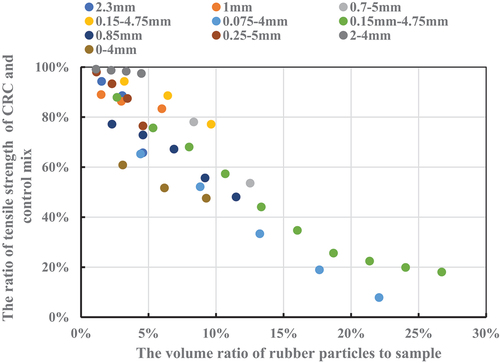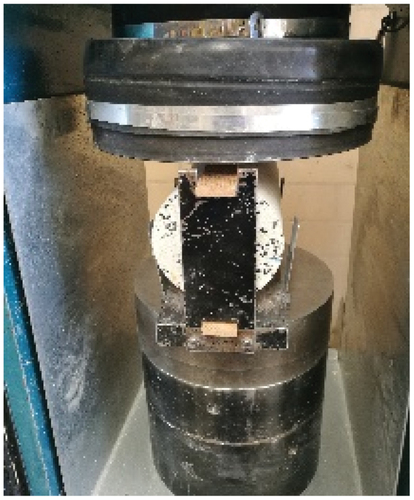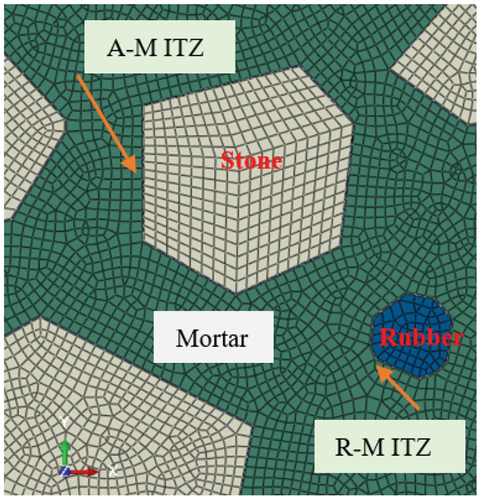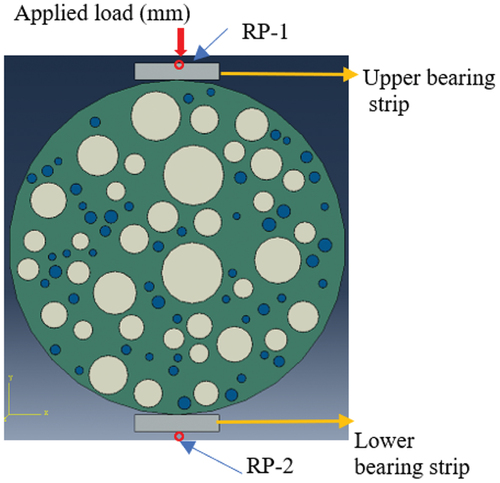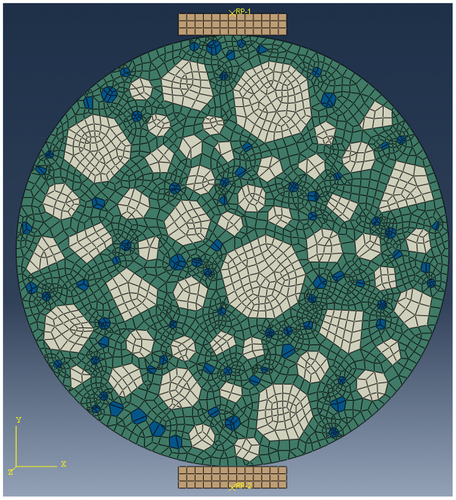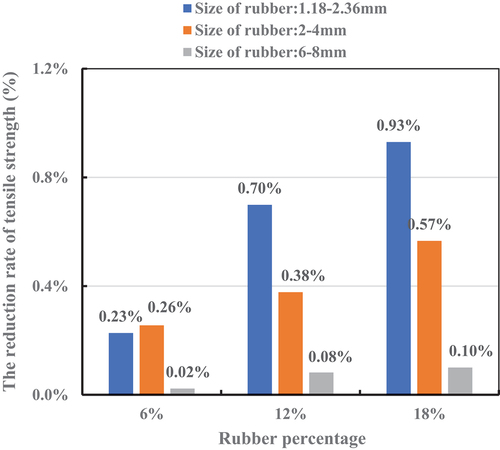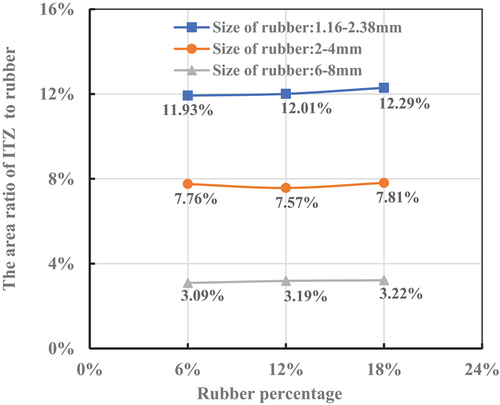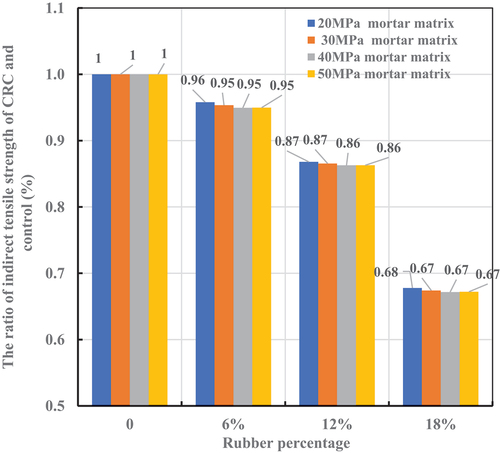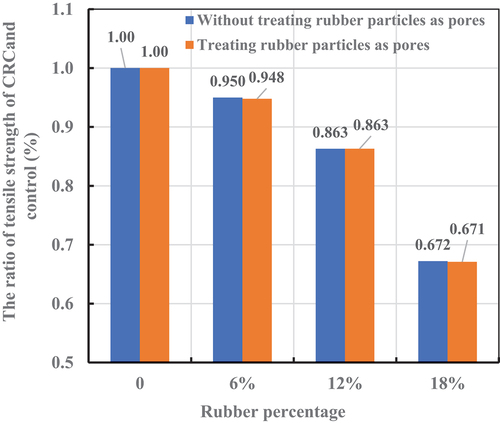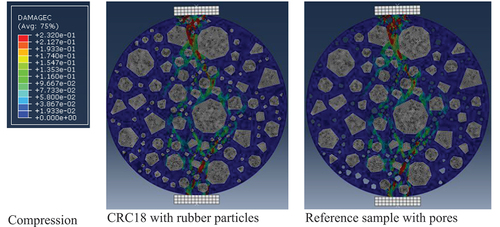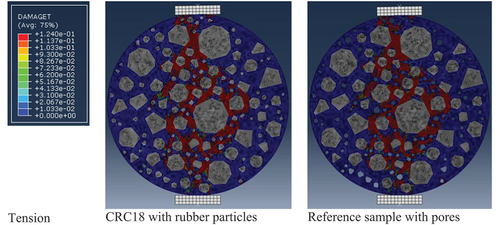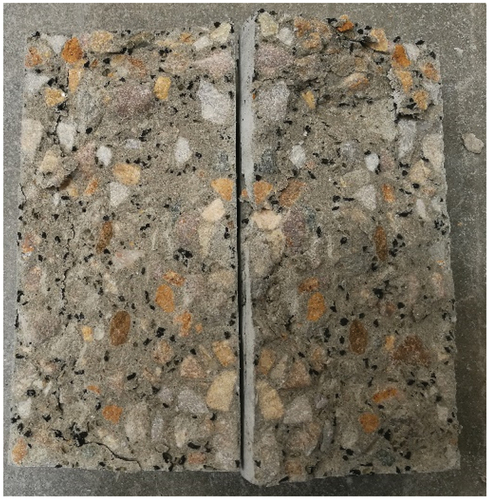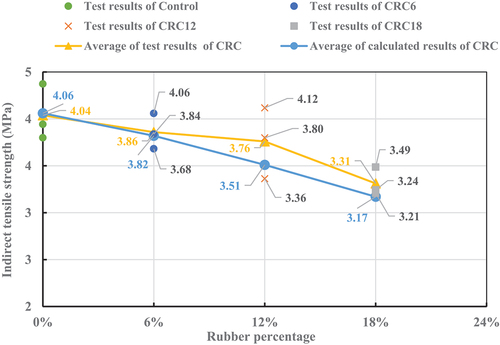 ?Mathematical formulae have been encoded as MathML and are displayed in this HTML version using MathJax in order to improve their display. Uncheck the box to turn MathJax off. This feature requires Javascript. Click on a formula to zoom.
?Mathematical formulae have been encoded as MathML and are displayed in this HTML version using MathJax in order to improve their display. Uncheck the box to turn MathJax off. This feature requires Javascript. Click on a formula to zoom.ABSTRACT
This study presents an experimental study and a mesoscale model for evaluating the tensile performance of crumb rubber concrete (CRC). In the experimental study, indirect tensile strengths of CRC with 6%, 12% 18% rubber contents were tested. Then the tested CRC samples were modelled as a five-phase material containing rubber, coarse aggregate, mortar, aggregate-mortar interface layer, and rubber-mortar interface layer. Numerical results from the mesoscale model agreed well with experimental tests. Parameter analysis was carried out to investigate the content, size, shape of rubber particle, thickness of interface layer on the tensile strength of CRC. Numerical results also indicated that rubber content was the governing influencing factor on the tensile strength reduction. As comparison, the influence from rubber size and rubber shape was relatively low. For a specimen with constant rubber content and size, changes in the distribution of rubber particles resulted in slight changes in the tensile strength of CRC as well. The effect of rubber particles on the tensile properties of concrete was similar to that of pores. Finally, tensile strength prediction formula was developed based on the pores model proposed in this study.
1. Introduction
Concrete is the most widely used construction material in civil industry. The production of concrete requires the mining of natural resources such as stone, river sand, and this has caused serious impact on the natural environment. Non-environmentally friendly disposal of waste tyres also causes significant environment impact. Applying rubber particles recycled from waste tyres as fine aggregates in crumb rubber concrete (CRC) can not only reduce the consumption of river sand, but also enable the large-scale use of waste tyres. Researchers have completed extensive experimental studies on the static and dynamic mechanical properties of CRC (Eltayeb, Ma, Zhuge, Youssf, and Mills Citation2020; Eltayeb et al. Citation2021; Li et al. Citation2016), durability (D. Li, Y. Gravina, et al. Citation2020) and its structural applications in reinforced CRC slabs (D. Li, Gravina, et al. Citation2020; Li, Xiao, et al. Citation2020; D. Li et al. Citation2018; Youssf et al. Citation2020, Citation2022), composite slabs (Yi et al. Citation2020, Citation2021), composite walls (Eltayeb, Ma, Zhuge, Youssf, Mills, and Xiao Citation2020; Eltayeb, Ma, Zhuge, Youssf, Mills, Xiao, et al. Citation2020) and connections (Chu et al. Citation2022). Concrete has low tensile strength, and cracking of concrete components under normal use affects its durability and serviceability (Bhanja and Sengupta Citation2005). Tensile strength is a common indicator of a concrete member’s resistance to cracking. The elastic modulus, Poisson’s ratio, and strength of rubber are obviously different from those of coarse aggregate and fine aggregate in concrete. Rubber is a hydrophobic material, which makes it difficult to form an effective bond with the mortar phase in concrete (Shahzad and Zhao Citation2022). The addition of rubber particles further causes uneven material distribution within the concrete. These two reasons have a great influence on the tensile properties of concrete. Researchers have carried out many experiments to study the tensile properties of rubber concrete, and the results in literature show that the tensile strength of rubber concrete decreases in direct proportion to the rubber content. compares the change in indirect tensile strength of CRC samples selected from 10 laboratory studies (Abdelmonem et al. Citation2019; Akbarzadeh Bengar et al. Citation2020; Al-Tayeb et al. Citation2013; Batayneh, Marie, and Asi Citation2008; Feng et al. Citation2018; Hilal Citation2011; Karahan et al. Citation2012; H. Liu et al. Citation2016; Lv et al. Citation2015; Onuaguluchi and Panesar Citation2014). As the rubber content increases from 0% to 35%, the strength ratio of rubber concrete to control mix gradually decreases. This indicates that the addition of rubber reduces the tensile strength of concrete, and the reduction rate increases with the increase in rubber content. In different studies, even if the rubber content is the same, such as 5%, there are large differences in the tensile strength reduction rate (see ). The available studies mainly focus on experimental tests, indicating that rubber decreases the tensile strength of concrete, but the reduction rate varies greatly in different studies. There is also no quantitative description of the influence of parameters such as the size, content, and distribution of rubber particles on the tensile strength of concrete.
Mesoscopic modelling is an effective tool for studying the mechanical behaviours of rubber concrete, in which establishing a two-dimensional or three-dimensional CRC structure is the main task. There are much fewer studies on numerical simulation of rubber concrete than experimental studies. Duarte et al. (Citation2015) and Duarte et al. (Citation2017) presented a two-mesoscale model of CRC, which was obtained using MATLAB processing methods. Finite element analysis was performed based on this model to evaluate the tensile strength of CRC. The results showed that the tensile strength of CRC is much lower than that of normal concrete, the location of rubber particles is prone to stress concentration, which is one reason for the reduction in CRC strength. The limitation of this study is that the model was based on a certain cross-section of the CRC specimen although the content of rubber particles on the cross-section at different locations could be different thus affected the numerical analysis results. Li et al. (Citation2019) investigated the direct tensile strength of self-compacting CRC by conducting 3D mesoscale simulation. The results showed that the toughness of CRC increased but the tensile load-bearing capacity reduced compared with ordinary concrete. Pan et al. (Citation2022) studied the dynamic compressive performance of CRC by perform 3D mesoscale analysis, indicating that CRC exhibits enhanced impact resistance and ability to delay crack growth at high load rates. Recently (Chen et al. Citation2021; Citation2023a; Citation2023b), applied mesoscale model to predict Young’s modulus of CRC, compressive strength and tensile strength of rubberised mortar.
This paper presents a mesoscopic numerical simulation to study how rubber affects the tensile properties of concrete. In the numerical study, the first task was to generate a mesoscale model of CRC through developing a Python program to distribute rubber particles and coarse aggregate within the boundaries of the CRC samples. Three-dimensional distribution of rubber particles and coarse aggregate in a real specimen was converted into a two-dimensional distribution on a plane. The shapes of rubber particles were idealised as circles and circle-derived polygons. The second task was to import the numerical model of CRC into ABAQUS for tensile test simulation. The effects of R-M ITZ, size, mortar matrix strength, and viewing rubber particles as pores on the tensile properties of CRC were studied. Based on the numerical simulation, a formula was obtained to predict the tensile strength of CRC and the results were in good agreement with tests.
2. Experiment program and mesoscale model generation
2.1. Sample preparation and test program
This study designed four concrete mixtures named Control, CRC6, CRC12, and CRC16, meaning to use rubber to replace 0%, 6%, 12%, and 18% of the sand volume in ordinary concrete. General-purpose cement produced by Adelaide Brighton cement, dolomite stone with a nominal size of 20 mm and 14 mm, natural sand. The rubber granules with a size of 2–4 mm used to make CRC test pieces were provided by an Australian company named ‘Tyrecycle’. The shape of the rubber particles is a random polyhedron. The specific gravity of sand, stone, rubber, and cement was 2.63, 2.71,1.14, and 3.15 respectively. The mix proportions of rubber concrete and the control mix are shown in .
Table 1. Mix proportions.
Three specimens with a diameter of 100 mm and 2 height of 200 mm were made for each type of mixture in accordance with AS 1012.8.1 (Citation2014). The tensile strength of CRC specimens was tested according to the procedure provided by AS 1012.10, A (Citation2000). A downward load was applied along the diameter of the sample at a rate of 0.8kN/s until it failed (see ).
2.2. Mesoscale models of CRC samples
CRC is viewed as a five-phase material (see ). shows a mesoscale model of the CRC18 sample used for indirect tensile testing. Chen et al. (Citation2023b) provided detailed steps of creating this model. Fibreboards with a thickness of 5 mm and a width of 25 mm were placed on the upper and lower parts of the samples as bearing strips. Loads and constraints were applied at reference points RP-1 and RP-2, respectively. The constraint between the bearing strip and the sample was specified as a tie, while the constraint between the bearing strip and the reference point was specified as a rigid body. In rubber concrete, the interface layer between rubber and mortar phases is called the rubber-mortar interface transition zone, and this area is abbreviated as ‘R-M ITZ’. Similarly, the interface layer between coarse aggregate and mortar phases is called the aggregate-mortar interface transition zone, and this area is abbreviated as ‘A-M ITZ’.
Nanoindentation tests were performed on the CRC to measure the hardness of R-M ITZ and A-M ITZ, which were 41–62% and 70–85% of the mortar phase, respectively. R-M ITZ has a loose structure and many micro-cracks, and its thickness is about 50-60um (Momotaz et al. Citation2023).In this study, the thickness of R-M ITZ and A-M ITZ was set to 0.05 mm. The strength and hardness was assumed to follow a linear relationship, which was used to determine the strength of R-M ITZ and A-M ITZ (Igarashi, Bentur, and Mindess Citation1996). The R-M ITZ and A-M ITZ strengths were set at 60% and 80% of the mortar matrix in the control concrete, respectively. Coarse aggregate and rubber particles are considered elastic materials. Mortar, R-M ITZ, and A-M ITZ were simulated using concrete damage plastic model. Coarse aggregates and rubber particles were randomly distributed within the boundary of the specimen. shows the material parameters of each phase in CRC.
Table 2. Material properties.
In this section, six sizes of rubber particles were considered when establishing mesoscale models of CRC. shows the rubber content in the 3D and 2D specimens. The element type of the finite element model of the CRC was specified as a 4-node plane stress (CPS4R) element with a thickness of 1 mm. The element shape was set to Quad-dominated, and free meshing techniques were used when meshing the numerical model.
Table 3. The content of rubber particles in 3D and 2D CRC samples.
When running the model in ABAQUS, a downward displacement was applied at RP-1 to compress the specimen until it failed. The maximum reaction force obtained at RP-1 was then substituted into Equation (1) to calculate the tensile strength. Since the thickness of the 2D mesoscale model was 1 mm, the value of L in Equation (1) was equal to 1 mm.
Where, T is the indirect tensile strength, in MPa; P is the maximum reaction force indicated by the ABAQUS modelling, in newtons; L is the length of the CRC specimen, in millimetres; D is the diameter, in millimetres.
2.3. Convergence analysis
The accuracy of finite element analysis is related to mesh density (Y. Liu and Glass Citation2013). A mesh convergency study was conducted by conducting mesoscale modelling of CRC specimens with element sizes ranging from 0.2 mm to 2 mm (see ). shows the tensile strengths of CRC models with different element sizes and compares them with experimental values. The change in the calculated tensile strength is within 2% as the element size increases from 0.2 mm to 0.8 mm. For models of CRC models with a 2 mm element size, the increase in tensile strength is more than 6%. To save computation time and ensure the accuracy of the results, an appropriate element size for the CRC model is 0.4–0.6 mm which can produce a suitable mesh to obtain acceptable results.
Table 4. Effect of element size on the tensile strength of CRC.
3. Results and discussion
3.1. Influencing factors
3.1.1. Effect of rubber particle shapes
Circles, ellipses, circle-derived polygons, and ellipse-derived polygons were used to simulate the shape of rubber particles and coarse aggregates. Six models were created for samples containing aggregates of each shape. shows the average ratio of the tensile strength of CRC to the control. Slightly higher tensile strengths were obtained when the aggregates were viewed as regular shapes such as circles and ellipses. The irregular edges of polygonal aggregates were more likely to cause higher stress concentration than the regular edges of circular and elliptical aggregates, which led to a decrease in tensile strength. The process of turning scrap tyres into recycled rubber pellets can be carried out in automated factories. Waste tyres are first shredded into small pieces and then processed into rubber pellets using a pelletiser (Fazli and Rodrigue Citation2020). In practical applications, rubber particles with a size of 2–4 mm are usually irregular polyhedrons with rough surfaces. Therefore, when creating a 2D model of a CRC sample, the actual shape of the rubber particles should be considered as a random polygon.
3.1.2. Effect of rubber-mortar interfacial layer
The interface between rubber and mortar, the R-M ITZ, is a weak area prone to cracking under low stress. The effect of the presence of R-M ITZ on the tensile strength of concrete needs to be studied. The shape of rubber particles was viewed as a circle-derived polygon, and the sizes of rubber particles considered in this section were 1.18–2.36 mm, 2-4 mm, and 6-8 mm. The tensile strength of CRC samples without R-M ITZ was first calculated. The tensile strength will be reduced after an interface layer was inserted between rubber and mortar phase in CRC specimens. The tensile strength reduction rate of CRC was calculated using (EquationEquation 2(2)
(2) ).
The presence of ITZ on the indirect tensile strength of CRC added with rubber particles of varying sizes was studied, as shown in . It was found that as the rubber content increased, the rate of decrease in tensile strength increased. The use of smaller size rubber particles (such as 1.16–2.38 mm) could result in a slightly higher reduction rate in tensile strength. The difference in tensile strength reduction rate was related to the content of R-M ITZ, which was determined by the area ratio of R-M ITZ to rubber (see ). As the rubber size increased from 1.16–2.38 mm to 6-8 mm, the R-M ITZ content decreased from around 11.93% to 3.09%, indicating that CRC samples containing larger size rubber particles had a smaller ITZ content and less tensile strength reduction.
Where is the tensile strength reduction of CRC,
is the tensile strength of CRC without R-M ITZ,
is the tensile strength of CRC with R-M ITZ.
3.1.3. Effect of rubber particle size
The parameters in this section included four rubber particle sizes of 1.77 mm, 3 mm, and 7 mm, and two rubber contents of 6% and 18%. Six CRC samples containing different distributions, but the same content of rubber particles was generated to evaluate how the tensile strength of CRC was affected by the location of rubber aggregates (see ). The tensile strengths of six CRC samples with different rubber particle distributions are shown in . The standard deviation was used to measure the dispersion of the six values of tensile strength. The results showed that the standard deviation and mean tensile strength of the CRC specimens did not change significantly with increasing rubber particle size.
Table 5. The tensile strength of CRC 6 and CRC18 with different aggregate distributions.
3.1.4. Effect of mortar matrix strength in CRC
This section studies the influence of changing the compressive strength of the mortar matrix on the tensile strength of CRC. The mortar phase in CRC with a compressive strength of 66.83MPa was reduced to four strengths:20MPa, 30MPa, 40MPa, and 50MPa, and they formed four types of CRC samples. The tensile strength and Young’s modulus of the mortar phase in the CRC samples with a compressive strength of 20-50MPa were obtained by a similar method. As shown in , for CRC samples with the same rubber content, the ratio of tensile strength between CRC and control mix remained unchanged as the compressive strength of the mortar phase changed from 20MPa to 50MPa. The rate of decrease in tensile strength was related to the rubber content rather than the compressive strength of the mortar matrix.
3.1.5. Simplifying rubber particles as pores
In this section, the rubber particles in CRC are regarded as pores with the same content, shape, and position. CRM samples containing with 2-4 mm rubber particles were first created, then reference samples were created by replacing the rubber particles with pores. compares the results of the two samples. Numerical results show that treating the rubber particles as pores hardly changes the reduction rate of tensile strength. It could be found from that the location of the damaged area in the reference sample is the same as that in the CRC sample. Adding a certain volume of rubber particles is equivalent to adding the same volume of voids into the mortar. These voids are irregular and weak areas inside the CRC sample, which interrupts the flow of stress.
Six pore-based models were established for CRC specimens with rubber contents of 6%, 12%, and 18%, respectively. The tensile strength of six CRC models at each rubber content was obtained by ABAQUS simulation, and the average value was taken as the calculation result, as shown in , indicating that a 6% increase in rubber content results in about a 7% decrease in tensile strength.
Table 6. The tensile strength of CRC obtained by numerical simulation.
4. Summary of numerical analysis
The above analysis indicates that the shape of rubber aggregate has a slight effect on the tensile strength of CRC. When the presence of R-M with a thickness of 0.05 mm is considered in CRC, its effect on the tensile strength of CRC is less than 1%, which can be neglected. The average strength of the CRC specimens added with varying sizes of rubber particles is similar, and their strength deviations are slightly different. The tensile strength reduction of CRC is not affected by the compressive strength of the mortar phase in CRC. Treating the rubber particles as pores and ignoring the presence of ITZ has a negligible effect on tensile strength and does not alter the failure mode of the CRC specimen.
4.1. CRC tensile strength prediction formula and validation
shows a curve describing the relationship between tensile strength and rubber content, which was obtained from the data in and expressed by Equation (3).
Where is the ratio of tensile strength of CRC and control concrete,
is the percentage of sand volume replaced by crumb rubber particles, with a value of 0–18%.
To facilitate the general application of Equation (2), the rubber content can be defined as the volume ratio of rubber to total volume of the specimen, denoted by . Since sand makes up 26.1% of the volume of the control mix in this study, the values of
for CRC6, CRC12, CRC18 are 1.57%, 3.13%, and 4.7%, respectively. Equation (2) can be revised to Equation (4).
The numerical results can be validated through the testing results in the experimental program. CRC samples for each rubber content have three test results, their average value is used as tensile strength, which is listed in . The damaged surface of the CRC18 sample is shown in .
Table 7. Test results of indirect tensile strength.
EquationEquation (3)(3)
(3) was used to determine the calculated results for the tensile strength of the CRC sample. As shown in the tensile strength of CRC decreases with increasing rubber content from 6% to 18%, and the difference between the calculated results and test results of CRC6, CRC12, and CRC18, is −1.01%, −6.64%, and −4.28%, respectively.
5. Conclusions
A mesoscale model considering CRC as a five-phase material was proposed to evaluate the influence of six factors on the tensile properties of CRC. Based on the parameter analysis results, a pore-based model was developed to predict the tensile strength of CRC, and the calculated results were in good agreement with the tested results. Voids and initial defects in rubber concrete are ignored, which may have some impact on the accuracy of numerical simulation results. This study can draw the following conclusions:
The addition of rubber particles results in a reduction in the tensile strength of concrete. The results of experimental tests and numerical simulations show that for every 6% increase in rubber content, the tensile strength of concrete decreases by 6.3% and 7.9% respectively. Rubber content is the main factor that determines the rate of tensile strength reduction.
Simplifying the rubber particles into different shapes has a slight influence on the results of numerical simulations of rubberised concrete. Since the shape of real rubber particles is a random polyhedron, it is recommended to treat rubber particles as polygons to build a two-dimensional model of rubber concrete.
As the rubber size and content increase, the effect of R-M ITZ on CRC tensile strength increases accordingly. For CRC specimens with a rubber content of 18% and a size of 2-4 mm, the effect of R-M ITZ on CRC tensile strength is 0.57%. The existence of the interface layer can be ignored when establishing the CRC mesoscale model.
The addition of rubber particles causes the internal material inhomogeneity of concrete to increase, which increases the dispersion of the tensile strength of rubber concrete. The loss of tensile strength of rubber concrete is mainly caused by the low stiffness of rubber. The location and vicinity of the rubber particles are weak areas. They are prone to cracking under low nominal stress and cause stress concentration, resulting in a reduction in the tensile strength of the CRC.
Authors’ statement
This paper is an extended version of a manuscript submitted to the 26th Australasian Conference on Mechanics of Structures and Materials (ACMSM26), held in Auckland, New Zealand, 3–6 December 2023.
Disclosure statement
No potential conflict of interest was reported by the author(s).
References
- 1012.10, A. 2000. 2000: Australian Standard 1012.10: Methods of testing concrete - Determination of indirect tensile strength of concrete cylinders (`Brazil’ or splitting test). Sydney: Standards Australia International Ltd.
- 1012.8.1, A. 2014. 2014: Australian Standard 1012.8.1: Methods of Testing Concrete Method 8.1: Method for Making and Curing Concrete — Compression and Indirect Tensile Test Specimens. Sydney: Standards Australia International Ltd.
- Abdelmonem, A., M. S. El-Feky, E.-S. A. R. Nasr, and M. Kohail. 2019. “Performance of High Strength Concrete Containing Recycled Rubber.” Construction and Building Materials 227:116660. https://doi.org/10.1016/j.conbuildmat.2019.08.041.
- Akbarzadeh Bengar, H., A. A. Shahmansouri, N. Akkas Zangebari Sabet, K. Kabirifar, and W. Y. Tam. 2020. “Impact of Elevated Temperatures on the Structural Performance of Recycled Rubber Concrete: Experimental and Mathematical Modeling.” Construction and Building Materials 255:119374. https://doi.org/10.1016/j.conbuildmat.2020.119374.
- Al-Tayeb, M. M., B. H. Abu Bakar, H. M. Akil, and H. Ismail. 2013. “Performance of Rubberized and Hybrid Rubberized Concrete Structures Under Static and Impact Load Conditions.” Experimental Mechanics 53 (3): 377–384. https://doi.org/10.1007/s11340-012-9651-z.
- Batayneh, M. K., I. Marie, and I. Asi. 2008. “Promoting the Use of Crumb Rubber Concrete in Developing Countries.” Waste Management 28 (11): 2171–2176. https://doi.org/10.1016/j.wasman.2007.09.035.
- Bhanja, S., and B. Sengupta. 2005. “Influence of Silica Fume on the Tensile Strength of Concrete.” Cement and Concrete Research 35 (4): 743–747. https://doi.org/10.1016/j.cemconres.2004.05.024.
- Chen, H., D. Li, X. Ma, Z. Zhong, and E.-S. Abd-Elaal. 2021. “Mesoscale Analysis of Rubber Particle Effect on young’s Modulus and Creep Behaviour of Crumb Rubber Concrete.” International Journal of Mechanics and Materials in Design 17 (3): 659–678. https://doi.org/10.1007/s10999-021-09552-y.
- Chen, H., D. Li, X. Ma, Z. Zhong, and E.-S. Abd-Elaal. 2023a. “Compressive Strength Prediction of Crumb Rubber Mortar Based on Mesoscale Model.” Engineering Failure Analysis 152:107485. https://doi.org/10.1016/j.engfailanal.2023.107485.
- Chen, H., D. Li, X. Ma, Z. Zhong, and E.-S. Abd-Elaal. 2023b. “Mesoscale Analysis of Rubber Particle Effect on Indirect Tensile and Flexural Tensile Strength of Crumb Rubber Mortar.” Journal of Composites Science 7 (1): 16. https://doi.org/10.3390/jcs7010016.
- Chu, L., S. Wang, D. Li, J. Zhao, and X. Ma. 2022. “Cyclic Behaviour of Beam-Column Joints Made of Crumb Rubberised Concrete (CRC) and Traditional Concrete (TC).” Case Studies in Construction Materials 16:e00867. https://doi.org/10.1016/j.cscm.2021.e00867.
- Duarte, A. P. C., B. A. Silva, N. Silvestre, J. de Brito, and E. Júlio. 2015. “Mechanical Characterization of Rubberized Concrete Using an Image-Processing/xfem Coupled Procedure.” Composites Part B: Engineering 78:214–226. https://doi.org/10.1016/j.compositesb.2015.03.082.
- Duarte, A. P. C., N. Silvestre, J. de Brito, and E. Júlio. 2017. “Numerical Study of the Compressive Mechanical Behaviour of Rubberized Concrete Using the eXtended Finite Element Method (XFEM).” Composite Structures 179:132–145. https://doi.org/10.1016/j.compstruct.2017.07.048.
- Eltayeb, E., X. Ma, Y. Zhuge, J. Xiao, and O. Youssf. 2021. “Dynamic Performance of Rubberised Concrete and Its Structural Applications–An Overview.” Engineering Structures 234:111990. https://doi.org/10.1016/j.engstruct.2021.111990.
- Eltayeb, E., X. Ma, Y. Zhuge, O. Youssf, and J. E. Mills. 2020. “Influence of Rubber Particles on the Properties of Foam Concrete.” Journal of Building Engineering 30:101217. https://doi.org/10.1016/j.jobe.2020.101217.
- Eltayeb, E., X. Ma, Y. Zhuge, O. Youssf, J. E. Mills, and J. Xiao. 2020. “Structural Behaviour of Composite Panels Made of Profiled Steel Sheets and Foam Rubberised Concrete Under Monotonic and Cyclic Shearing Loads.” Thin-Walled Structures 151:106726. https://doi.org/10.1016/j.tws.2020.106726.
- Eltayeb, E., X. Ma, Y. Zhuge, O. Youssf, J. E. Mills, J. Xiao, and A. Singh. 2020. “Structural Performance of Composite Panels Made of Profiled Steel Skins and Foam Rubberised Concrete Under Axial Compressive Loads.” Engineering Structures 211:110448. https://doi.org/10.1016/j.engstruct.2020.110448.
- Fazli, A., and D. Rodrigue. 2020. “Recycling Waste Tires into Ground Tire Rubber (GTR)/Rubber Compounds: A Review.” Journal of Composites Science 4 (3): 103. https://doi.org/10.3390/jcs4030103.
- Feng, W., F. Liu, F. Yang, L. Li, and L. Jing. 2018. “Experimental Study on Dynamic Split Tensile Properties of Rubber Concrete.” Construction and Building Materials 165:675–687. https://doi.org/10.1016/j.conbuildmat.2018.01.073.
- Hilal, A. A. 2011. “Effect of Crumb Tyres Rubber on Some Properties of Foamed Concrete.” Anbar Journal for Engineering Sciences AJES-2011 4 (2): 1–17. https://www.iasj.net/iasj/download/a311455ab5f285bb.
- Igarashi, S., A. Bentur, and S. Mindess. 1996. “Microhardness Testing of Cementitious Materials.” Advanced Cement Based Materials 4 (2): 48–57. https://doi.org/10.1016/S1065-7355(96)90051-6.
- Karahan, O., E. Özbay, K. M. A. Hossain, M. Lachemi, and C. D. Atiş. 2012. “Fresh, Mechanical, Transport, and Durability Properties of Self-Consolidating Rubberized Concrete.” ACI Materials Journal 109:413–420. https://doi.org/10.14359/51683916.
- Li, X., X. Chen, A. P. Jivkov, and J. Zhang. 2019. “3D Mesoscale Modeling and Fracture Property Study of Rubberized Self-Compacting Concrete Based on Uniaxial Tension Test.” Theoretical and Applied Fracture Mechanics 104:102363. https://doi.org/10.1016/j.tafmec.2019.102363.
- Li, D., Y. Gravina, R. Zhuge, T. Benn, and J. E. Mills. 2020. “Creep and Drying Shrinkage Behaviour of Crumb Rubber Concrete (CRC).” Australian Journal of Civil Engineering 18 (1): 1–18. https://doi.org/10.1080/14488353.2019.1680073.
- Li, D., R. Gravina, Y. Zhuge, and J. E. Mills. 2020. “Bond Behaviour of Steel-Reinforcing Bars in Crumb Rubber Concrete (CRC).” Australian Journal of Civil Engineering 18 (1): 2–17. https://doi.org/10.1080/14488353.2019.1680073.
- Li, D., J. E. Mills, T. Benn, X. Ma, R. Gravina, and Y. Zhuge. 2016. “Review of the Performance of High-Strength Rubberized Concrete and Its Potential Structural Applications.” Advances in Civil Engineering Materials 5 (1): 149–166. https://doi.org/10.1520/ACEM20150026.
- Liu, Y., and G. Glass. 2013. “Effects of Mesh Density on Finite Element Analysis.” SAE Technical Paper 7. https://doi.org/10.4271/2013-01-1375.
- Liu, H., X. Wang, Y. Jiao, and T. Sha. 2016. “Experimental Investigation of the Mechanical and Durability Properties of Crumb Rubber Concrete.” Materials 9 (3): 172. https://doi.org/10.3390/ma9030172.
- Li, D., J. Xiao, Y. Zhuge, J. E. Mills, H. Senko, and X. Ma. 2020. “Experimental Study on Crumb Rubberised Concrete (CRC) and Reinforced CRC Slabs Under Static and Impact Loads.” Australian Journal of Structural Engineering 21 (4): 294–306. https://doi.org/10.1080/13287982.2020.1809811.
- Li, D., Y. Zhuge, R. Gravina, and J. E. Mills. 2018. “Compressive Stress Strain Behavior of Crumb Rubber Concrete (CRC) and Application in Reinforced CRC Slab.” Construction and Building Materials 166:745–759. https://doi.org/10.1016/j.conbuildmat.2018.01.142.
- Lv, J., T. Zhou, Q. Du, and H. Wu. 2015. “Effects of Rubber Particles on Mechanical Properties of Lightweight Aggregate Concrete.” Construction and Building Materials 91:145–149. https://doi.org/10.1016/j.conbuildmat.2015.05.038.
- Momotaz, H., M. Rahman, M. Karim, Y. Zhuge, X. Ma, and P. Levett. 2023. “Properties of the Interfacial Transition Zone in Rubberised Concrete–An Investigation Using Nano-Indentation and EDS Analysis.” Journal of Building Engineering 77:107405. https://doi.org/10.1016/j.jobe.2023.107405.
- Onuaguluchi, O., and D. K. Panesar. 2014. “Hardened Properties of Concrete Mixtures Containing Pre-Coated Crumb Rubber and Silica Fume.” Journal of Cleaner Production 82:125–131. https://doi.org/10.1016/j.jclepro.2014.06.068.
- Pan, L., H. Hao, J. Cui, and T. M. Pham. 2022. “Numerical Study on Dynamic Properties of Rubberised Concrete with Different Rubber Contents.” Defence Technology 24:228–240. https://doi.org/10.1016/j.dt.2022.04.007.
- Shahzad, K., and Z. Zhao. 2022. “Experimental Study of NaOH Pretreated Crumb Rubber as Substitute of Fine Aggregate in Concrete.” Construction and Building Materials 358:129448. https://doi.org/10.1016/j.conbuildmat.2022.129448.
- Yi, O., J. E. Mills, Y. Zhuge, X. Ma, R. J. Gravina, and O. Youssf. 2020. “Case Study of the Structural Performance of Composite Slabs with Low Strength CRC Delivered by Concrete Truck.” Case Studies in Construction Materials 13:e00453. https://doi.org/10.1016/j.cscm.2020.e00453.
- Yi, O., Y. Zhuge, X. Ma, R. J. Gravina, J. E. Mills, and O. Youssf. 2021. “Push-Off and Pull-Out Bond Behaviour of CRC Composite Slabs–An Experimental Investigation.” Engineering Structures 228:111480. https://doi.org/10.1016/j.engstruct.2020.111480.
- Youssf, O., J. E. Mills, T. Benn, Y. Zhuge, X. Ma, R. Roychand, and R. Gravina. 2020. “Development of Crumb Rubber Concrete for Practical Application in the Residential Construction Sector–Design and Processing.” Construction and Building Materials 260:119813. https://doi.org/10.1016/j.conbuildmat.2020.119813.
- Youssf, O., J. E. Mills, M. Ellis, T. Benn, Y. Zhuge, X. Ma, and R. J. Gravina. 2022. Practical Application of Crumb Rubber Concrete in Residential Slabs, Structures, 837–853. Vol. 36. Elsevier. https://doi.org/10.1016/j.istruc.2021.12.062.

